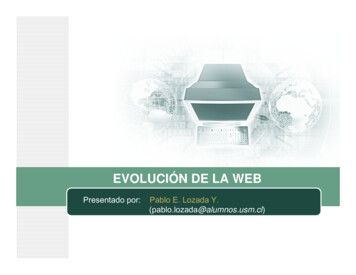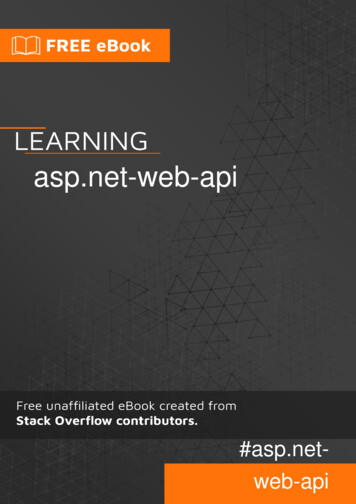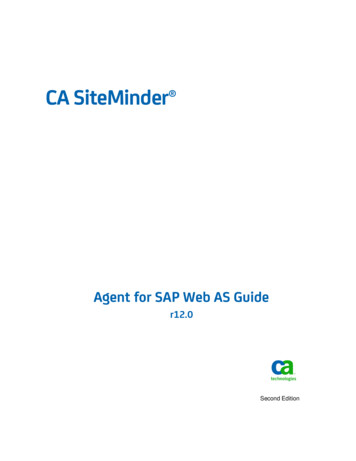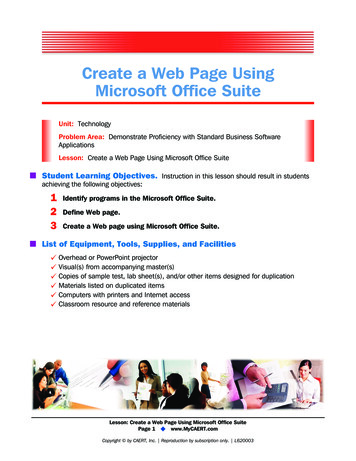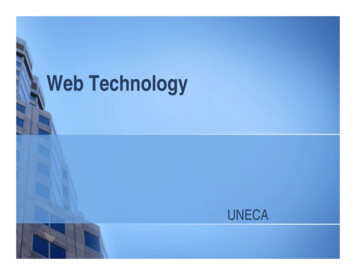
Transcription
Web TechnologyUNECA
Introduction to Web Technology Web technologies refers to the way computers/devices communicatewith each other using mark up languages. It invo It is communicationacross the web, and create, deliver or manage web content usinghypertext markup language (HTML).A web page is a web document which is written in in HTML (hypertextmarkup language)It is said to have brought the world into a small village where people anddevices can communicate to each other seamlessly.WWW has allowed for the access of information that would have beenimpossible to find or may have been difficult to find without the www.
The Internet & World WideWeb(WWW) The terms Internet and the World Wide Web are synonymous in the minds ofmany, but they have different meanings.The Internet is a massive network of networks that connects millions ofcomputers worldwide. Computers connected to the Internet can communicate with one another witha number of protocols such as HTTP, SMTP (Simple Mail Transfer Protocol),FTP (File Transfer Protocol), IRC (Internet relay chat), IM (instant messaging),Telnet, and P2P (peer-to-peer).The World Wide Web is a system of interlinked hypertext documents andprograms that can be accessed via the Internet primarily by using HTTP
Important terms of WebTechnology Web pageHTMLWeb ServerWeb BrowserURLProtocolInternet Protocol (IP) AddressHTTPXMLGatewayAPI
Some web components Web – Page A document which can be displayed in a webbrowser such as Firefox, Google Chrome, Opera,Microsoft Internet Explorer or Edge, or Apple's Safari.These are also often called just "pages.WebSite A collection of web pages which are groupedtogether and usually connected together in various ways.Often called a "web site" or simply a "site.“Web Server A special high end computer that hosts awebsite on the Internet. Today we have Cloud servicesthat act as web servers.
Dynamic v/s Static Pages Static pages show the same content each time they are viewed.Dynamic pages have content that can change each time they areaccessed.Dynamic pages are typically written in scripting languages such asPHP, Perl, ASP, or JSP. The scripts in the pages run functions on theserver that return things like the date and time, and databaseinformation.All the information is returned as HTML code, so when the page gets toyour browser, all the browser has to do is translate the HTML.
HTML HTML is a language which is used to create static web pages. HTML is the Language of Web Pages on the World Wide Web. HTML uses bracketed commands called ‘HTML tags’ that are integratedinto a text document. HTML code can be written in a text editor (like Notepad). Save the text editor file with “.htm” or “.html” extension. Open the file with any web browser(Like Internet Explorer, Firefox) to see theHTML page output.
Basic HTML Tags HTMLHEADBODYtitle (page title),style (rendering style),link (related documents),meta (data about thedocument),script (client-side scripting
Example html body h1 My First Heading /h1 p My first paragraph. /p /body /html
Web Browser A web browser is an application program for retrieving,presenting and traversing information resources on the WorldWide Web.An information resource is identified by a Uniform ResourceIdentifier (URI) and may be a web page, image, video or otherpiece of content.Some examples of web browser: Internet ExplorerGoogle Chrome,Firefox,Opera,Safari
Web Server A Web server is a program or computer machinethat generates and transmits responses to clientrequests for Web resources using HTTP protocol.Every computer on the Internet that contains aWeb site must have a Web server program.Any computer can be turned into a Web server byinstalling server software and connecting themachine to the Internet.
How Web Servers Work
Some Examples of Web Server Apache HTTP Server:The Apache HTTP Server, commonly referred to as Apache is a web server software programwhich gave the initial boost for the growth of the World Wide Web.In 2009, it became the first web server software to surpass the 100 million website milestone.The server is aimed at serving a great deal of widely popular modern web platforms/operatingsystems such as Unix, Windows, Linux, Solaris, Novell NetWare, FreeBSD, Mac OS X,Microsoft Windows, OS/2, etc.Microsoft Internet Information Services (IIS):IIS is one of the components of Microsoft Windows and is Microsoft's implementation of a webserver.The protocols supported include HTTP, HTTPS, FTP, FTPS & SMTP .It's estimated that around 25% of all websites utilize IIS.
URL URL stands for Uniform Resource Locator.A URL is a formatted text string used by Webbrowsers, email clients and other software toidentify a network resource on the Internet.Network resources are files that can be plain Webpages, other text documents, graphics, orprograms.
URL.continued URL strings consist of three parts (substrings):1. network protocol: Typical URL protocols includehttp:// and ftp:// .2. host name or address: identifies a computer orother network device. Hosts come from standard Internetdatabases such as DNS and can be names or IPaddresses. 3. file or resource location:These substrings are separated by specialcharacters as follows:protocol :// host / location
URL Example:In http://www.uneca.org/acs
Protocol A protocol is a set of rules that govern datacommunications.A protocol defines what is communicated, how it iscommunicated, and when it is communicated.It represents an agreement between thecommunicating devices.Without a protocol, two devices may be connectedbut not communicating, just as a person speakingPortuguese cannot be understood by a personwho speaks only English.
HTTP HTTP stands for HyperText Transfer Protocolit is the language of the Web.HTTP is a protocol used for communication between webbrowsers and web servers.When a web page has this prefix, then your links, text, andpictures should work in your web browserHTTP functions as a request-response protocol in theclient-server computing model.
HTTP. continued A web browser, for example, may be the client and anapplication running on a computer hosting a web site maybe the server.The client submits an HTTP request message to theserver.The server, which provides resources such as HTML filesand other content, or performs other functions on behalf ofthe client, returns a response message to the client.
API (Application ProgrammingInterface ) Application Programming Interface (API) whichconstitutes a language and message format is setof data structures, routines or protocols used by anapplication to communicate with other controlprogram, communication protocol or operatingsystem. Exampled would be a “Places API” whichis called by many web based applications.
Web Technologies HTML (HyperText Markup Language)XML (Extensible Markup Language)CSS (Cascading Style Sheets)JavaScriptJavaVBScriptPHPC#ASPASP.NET
REFERENCES
THANK YOU
HTML HTML is a language which is used to create static web pages. HTML is the Language of Web Pages on the World Wide Web. HTML uses bracketed commands called 'HTML tags' that are integrated into a text document. HTML code can be written in a text editor (like Notepad). Save the text editor file with ".htm" or ".html" extension.






